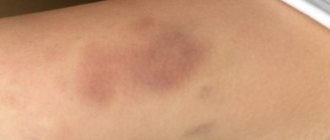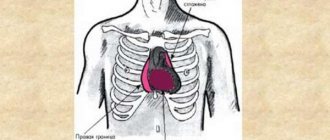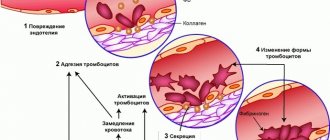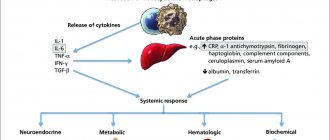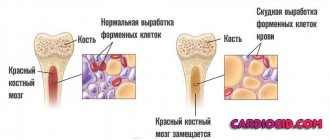- June 25, 2018
- Tests and diagnostics
- Alexandra Goptar
To maintain normal functioning of internal organs, each of them must receive adequate blood supply. Therefore, the blood in the body should be of moderate viscosity - not too liquid, but not too viscous. In this state, the blood is maintained by two systems that are in constant balance with each other - coagulation and anti-coagulation. But some pathological conditions can upset the balance of these two systems, causing severe, deadly complications.
As a separate diagnosis, bleeding disorders do not exist in ICD 10. However, there are five groups that include more than a dozen diseases under this name:
- D65 - disseminated intravascular coagulation;
- D66 - hereditary deficiency of factor VIII;
- D67 - hereditary deficiency of factor IX;
- D68 - other coagulation disorders;
- D69 - purpura and other hemorrhagic conditions.
The most common of them will be discussed in this article.
Main phases of hemostasis
Why don't we bleed when we are wounded? Why is she able to stop on her own? The coagulation system, or hemostasis, prevents the development of bleeding disorders. There are two types of hemostasis: vascular and coagulation.
Vascular hemostasis is provided by special blood cells - platelets. They literally stick to the vascular wall, quickly closing its lumen and preventing further bleeding. Vascular hemostasis acts quickly, but for a short time.
After the vascular one, the coagulation mechanism is included in the robot. It is ensured by the work of special proteins - coagulation factors, which are produced in the liver. There are three main stages of coagulation hemostasis:
- The first stage is the formation of tissue thromboplastin.
- At the second stage, thrombin is formed from prothrombin under the influence of thromboplastin.
- At the final stage, fibrin fibers are formed - connective tissue, which, firmly adhering to each other and the wall of the vessel, ensure the final stop of bleeding.
Other factors affecting clotting
You should know that if your blood is thick, it is not recommended to use certain medications that increase its viscosity. These include:
- Medicines that have a diuretic effect.
- Oral contraceptives.
- Viagra.
- Hormonal pharmaceuticals.
If you are taking one of these drugs and have thick blood, you should consult with your local doctor about the possibility of further use of the drug.
Smoking and excessive alcohol consumption also negatively affect blood health. Drinking and smoking people need to get rid of bad habits as soon as possible.
Sometimes you can bring your blood back to normal with the help of a special diet and sufficient fluid intake. But more often, increased coagulability is a consequence of some pathological process occurring in the body. In such cases, it is possible to normalize blood counts only after eliminating the underlying disease that led to its thickening.
Causes of coagulation disorders
Violation of the internal coagulation mechanism (coagulation) usually occurs through the mechanism of hypocoagulation, that is, insufficient blood clotting.
Here are the main causes of bleeding disorders:
- Hemophilia is a hereditary disease that is transmitted on the sex X chromosome. In most cases, boys are affected. This disease causes a violation of coagulation hemostasis. There are several types of hemophilia: with a lack of clotting factor VIII, hemophilia A develops, with a decrease in factor IX, hemophilia B develops.
- Hypocoagulation when taking medications. A separate group includes people taking medications that reduce clotting. The main drug is Warfarin. It is usually prescribed for diseases of the cardiovascular system to prevent the development of heart attacks and strokes. But sometimes, with long-term use of such drugs, pathological hypocoagulation can develop. Therefore, it is so important when taking Warfarin to regularly do a coagulogram, with which you can monitor blood clotting.
- Hemorrhagic disease of the newborn. A dangerous disease that manifests itself in the first three days of a child’s life and occurs due to a disruption in the liver’s production of vitamin K, which is necessary for the formation of many clotting factors.
- Infectious liver diseases, which also lead to a decrease in the formation of coagulation factors.
Vitamin K for newborns
However, in this regard, I would like to recall one more pathology, which manifests itself very sharply in a child immediately after birth and erases its symptoms with every day of life. This is a hemorrhagic disease of newborns , developing with a deficiency of FII, FVII, FIX, FX, the synthesis of which depends on vitamin K. In such cases, the role of the liver cannot be excluded, because in newborns it has not yet reached its functional maturity.
Immediately after birth, the level of the above factors barely approaches 50% and immediately begins to fall rapidly, reaching a minimum by 2-3 days of life. At best, the disease manifests itself as bleeding from the umbilical wound and hematuria (blood in the urine); at worst, it can lead to serious complications: severe bleeding, intracranial hemorrhage, and the development of hypovolemic shock.
If the pathology is detected in a timely manner and doctors manage to avoid complications, then the concentration of factors in the blood gradually increases, although for some time, several weeks, it does not reach their level in the blood of an adult.
Treatment is vitamin K preparations. By the way, it should be noted that cow’s milk is noticeably superior in vitamin K content to women’s milk. It is also added to milk formulas intended for artificial infants, so breast-fed children are more likely to develop symptoms of the disease.
Causes of impaired vascular hemostasis
Vascular or platelet hemostasis can be impaired for a number of reasons. Both damage to the vascular wall and inferiority or decrease in the number of platelets are possible.
The causes of bleeding disorders when the platelet mechanism is damaged include the following diseases:
- Thrombocytopenic purpura is an immune disease characterized by a decrease in platelet counts. It can be either hereditary, in which case it is called “Idiopathic thrombocytopenic purpura,” or acquired – after infections, medications, injuries, stress.
- Thrombocytopathies are a large group of familial diseases characterized by impaired quality of platelets with normal platelet numbers.
Bleeding disorders: causes
Coagulation hemostasis is a complex of complex biochemical processes that are triggered by tissue platelet factor and regulated by many blood coagulation factors. When it works correctly, it ensures that the damaged area of the vessel is blocked by a blood clot, which is called red because it contains red blood cells. About forty physiological active substances take part in the process. Any deviations in the balance of coagulation factors lead to disruptions in the process. In addition, platelet count plays an important role.
| Groups of violations | Etiological factors |
| Congenital/genetic | Coagulopathies that are inherited and caused by a lack of plasma coagulation factors are hemophilia; Hemorrhagic diathesis - angihemophilia, which is provoked by a deficiency of antihemophilic globulin; Disseminated intravascular coagulation, which develops as a result of hyperstimulation and deficiency of reserves of the hemostatic system; Thrombocytopenic purpura - occurs due to a deficiency of platelets due to disorders of the immune mechanisms. |
| Purchased | Pathological conditions that initiate a decrease in the level of fibrinogen or platelets in the blood:
|
| Autoimmune | Accelerated destruction of platelets in the spleen and a decrease in their number in the blood. |
Symptoms of hemophilia
Hemophilia is the leading cause of bleeding disorders in children. It almost never occurs in girls, but they can be carriers of the disease and pass the hemophilia gene to their offspring.
Main symptoms include:
- Frequent nose and ear bleeding.
- Formation of hematomas of varying sizes throughout the body, and the size and number of hematomas do not correspond to the nature of the injury. In severe cases, bruises appear spontaneously, without a previous blow.
- Bleeding several hours after surgery. For example, after a tooth extraction there may be no prolonged bleeding, but it suddenly begins after a few hours. This is due to the fact that in hemophilia the second link of hemostasis is disrupted - coagulation, while platelet is normal.
- Hemorrhages in the joints - hemarthrosis. This symptom is very characteristic of hemophilia and is manifested by joint swelling, redness, and pain when moving. Frequent hemarthrosis can lead to destruction of articular cartilage, which requires surgical intervention.
The main symptom is increased bleeding
The distinction between coagulopathies (hereditary and acquired) is carried out based on the patient’s family and personal history, as well as on the basis of laboratory tests.
As a rule, congenital pathology manifests itself with increased bleeding, without waiting for the person to become an adult. A child who received hemophilia from his mother early develops hematomas and hemorrhages in the muscles and joints, which often disrupts the function of the musculoskeletal system in childhood and causes disability. In von Willebrand disease, bleeding is especially prolonged over time, and this is confirmed by laboratory tests (the duration of bleeding increases, platelet aggregation is impaired under the influence of ristomycin).
signs of reduced blood clotting, incl. for hereditary reasons
Poor blood clotting most often manifests itself:
- The formation of bruises, which often arise on their own (“out of nowhere”) or after microtraumas, which are completely insignificant;
- Nosebleeds, gum bleeding or bleeding from minor scratches, not to mention cuts;
- Rash of various types;
- In other cases (hemophilia, for example) - large hematomas and poorly controlled bleeding.
Probably, the reader has already realized that low blood clotting can be very life-threatening, so a patient suffering from such a pathology needs mandatory medical supervision and his immediate intervention if circumstances require it.
Symptoms of thrombocytopenic purpura
Since the mechanism of development of purpura is fundamentally different from hemophilia, because another link of hemostasis is disrupted, the symptoms of a blood clotting disorder will vary significantly:
- Spontaneous small asymmetrical hemorrhagic rashes throughout the body (petechiae), in contrast to massive bruises in hemophilia. Also, the rash can be localized on the mucous membranes.
- Bleeding immediately after surgery, not hours later.
- Hemorrhages from the nose, gums; girls may also experience menorrhagia (long, bloody menstruation).
It doesn't matter whether it's a man or a woman...
In addition to the above forms of the disease, there are other varieties:
- Hemophilia C (factor XI deficiency), which can affect both men and women, since the type of inheritance in this case is different: it is not sex-linked, the gene is located on an autosome (not a sex chromosome), and can be either recessive or dominant;
- Hemophilia D is the rarest congenital coagulopathy and is caused by Hageman factor (FXII) deficiency. The type of inheritance is autosomal dominant, so the disease can affect both males and females equally.
In contrast to types A and B, hemophilia C most often occurs without any symptoms. Hematomas and spontaneous bleeding in hemophilia C are rare, except after serious injuries or surgery (that’s when the diagnosis is made), so people often live and do not know about their disease if they have never had to deal with problems of this kind in life.
Hemophilia D is also less dangerous than A and B - it does not give obvious symptoms, it is manifested by reduced blood clotting, which can be noticed during laboratory tests (extension of blood clotting time). Typically, such tests are prescribed before any surgical intervention.
However, women suffer more from hemophilia D, as it can be difficult for them to bear a child - they may constantly suffer from repeated spontaneous miscarriages.
Called pseudohemophilia , von Willebrand disease is an autosomal dominant hereditary pathology involving deficiency of a factor with the same name involved in the adhesion of blood platelets - platelets. This anomaly is characterized by the occurrence from time to time of spontaneous bleeding, which is characterized by a particular duration, which is associated with a violation of blood clotting in three positions at once (proteolysis and decrease in FVIII, dilation of blood vessels beyond any measure and increased permeability of their walls). In patients suffering from this disease, a violation of vascular-platelet hemostasis is clearly visible. Von Willebrand disease has several subtypes.
Diagnostics
To make a diagnosis of a blood clotting disorder, it is necessary to pay special attention to the collection of complaints and medical history of the patient, his family history of diseases, and physical examination data. Only after a comprehensive conversation and examination of the patient can we proceed to laboratory diagnostic methods. The main condition for conducting such tests is that they are non-traumatic, and that they must be carried out before the start of treatment.
The main methods for diagnosing bleeding disorders:
- Complete blood count with platelet count determination.
- Bleeding time and clotting time.
- Activated partial thromboplastin time (aPTT).
- Prothrombin and thrombin time.
- Plasma recalcification time.
What you need to know about the products
Blood viscosity can also be adjusted using certain products. So, some of them contribute to thickening, so it is better to exclude them from the patient’s diet. Other products have the ability to liquefy. Therefore, every patient should know what increases blood clotting and what diet helps make it less thick.
They have liquefying properties:
- Berries - cranberries, grapes, gooseberries, cherries and cherries, strawberries, red currants, blueberries.
- Fruits - oranges, apples, peaches, lemons.
- Vegetables - cucumbers, tomatoes, beets.
- Spices - ginger root, cinnamon, celery root and leaves, garlic, chili pepper.
- Seafood - red and white fish, seaweed.
- Drinks - cocoa, coffee, dark chocolate.
Products that increase clotting:
- Sugar.
- Buckwheat porridge.
- Alcohol.
- Carbonated drinks.
- Smoked products.
- Bananas.
- Liver.
- Radish.
- Nuts.
- Pomegranate.
- Parsley.
- White bread.
- Beans and peas.
- Salt.
- Potato.
- Fatty protein foods.
- Butter.
Treatment
Treatment of bleeding disorders directly depends on what disease caused the development of the disease. The basic rule is this: with increased blood coagulation, it is necessary to prescribe drugs that thin the blood (anicoagulants, antiplatelet agents), and with decreased coagulation, drugs that increase coagulation (clotting factors, vitamin K, antihemorrhagic drugs) should be prescribed. More details about when to use certain groups of medications, as well as what side effects may occur when taking them, will be discussed below.
Causes of poor blood clotting
The human body is a complex mechanism in which each component performs a function necessary for life.
For example, blood delivers nutrients and oxygen to organs and cells, removes carbon dioxide and waste products, prevents bleeding and performs other vital functions. You can notice circulatory disorders yourself in everyday life.
If a person has poor clotting ability, then the bleeding from cuts does not stop for a long time, subcutaneous hematomas and bruises appear. These signs indicate a coagulation disorder and the need for treatment.
Causes of bleeding disorders
Keeping blood in a liquid state, stopping bleeding when the integrity of blood vessels is violated, and dissolving blood clots is ensured by the hemostasis system, which includes three components: vascular-platelet hemostasis, coagulation hemostasis (clotting), fibrinolysis (dissolution of a blood clot). The coagulation process is regulated by the endocrine and nervous systems. Due to the liquid state of the blood, cells move freely through the vessels and perform functions.
The reasons why bleeding disorders occur are as follows:
- liver pathologies;
- lack of calcium;
- hemolytic anemia - a group of diseases accompanied by increased destruction of red blood cells;
- leukemia is an oncological disease of the hematopoietic system;
- significant blood loss;
- thrombocytopenia, of various etiologies - a condition characterized by a low level of platelets;
- genetic disorders of the fibrinogen production process;
- lack of vitamin K;
- DIC syndrome - disseminated intravascular coagulation;
- hereditary bleeding disorders (hemophilia, von Willebrand disease);
- anticoagulant therapy - drugs that prevent the formation of blood clots and inhibit clotting;
- vasculitis is a group of diseases accompanied by immunopathological inflammation of blood vessels.
There are other reasons that affect the coagulation process. For example, long-term use of non-steroidal anti-inflammatory drugs (aspirin, diclofenac, ibuprofen and others) in large doses causes thrombocytopenia. There is a high likelihood of developing poor clotting in people who are prescribed treatment for varicose veins and thrombophlebitis.
Symptoms of a bleeding disorder
As a rule, the main symptom of poor blood clotting is prolonged and unstoppable bleeding. In women, this can be expressed in increased discharge during menstruation. In case of household injuries, the bleeding does not stop for a long time. Also, symptoms indicating a coagulation disorder include:
- the appearance of bruises for no reason;
- frequent nosebleeds;
- hemorrhages on the skin (petechiae, ecchymoses, bruises);
- subcutaneous blood collections;
- hemorrhages of the internal linings of the intestines, nasal and oral cavities. hemorrhages in the intestines can cause blood clots in the stool;
- hemorrhages in the brain;
- If the cause of the disorder is hemophilia, then hemorrhages in joints, muscle tissue and other internal organs are possible.
If symptoms indicating a coagulation disorder appear, you need to consult a doctor and take a coagulation test. The danger of poor clotting is that traumatic injuries can lead to heavy blood loss.
As part of the analysis, the time during which the blood clots and other important indicators of the hemostatic system are determined.
Having studied complaints and symptoms in conjunction with research results, the doctor determines why the coagulation process is disrupted and prescribes appropriate treatment.
Treatment and prevention
Having established the cause of the clotting disorder, the doctor prescribes treatment and gives recommendations for prevention.
If reduced coagulation is caused by pathological abnormalities, then therapy is primarily aimed at eliminating the disease that prevents blood clotting.
By eliminating unfavorable factors that affect the coagulation process, blood functions are gradually normalized. In addition, blood clotting agents may be prescribed.
Drug treatment that increases coagulation is based on taking vitamin K and drugs that enhance coagulation.
If, according to the results of a coagulogram, the blood does not clot in the normal time due to thrombocytopenia, then a transfusion of donor platelets is used. If heavy blood loss has already occurred, medications containing iron and foods with a high content of iron are prescribed. To replenish the volume of lost blood, they resort to blood transfusion (transfusion).
The effectiveness of treatment increases with an integrated approach. Along with drug therapy, adjustments are made to the diet and diet.
The products consumed must contain substances such as calcium, folic acid, vitamin K, and amino acids. It is useful to add green onions, cabbage, and spinach to your diet. The basic diet includes milk, cheese, cottage cheese, and fermented milk products.
To quickly replenish the supply of nutrients, fortified preparations are prescribed.
Equally important during treatment is the correct lifestyle. It is necessary to exclude bad habits (alcohol, smoking) and foods that negatively affect coagulation. The amount of sugar consumed should be reduced to a minimum. If blood thinners are prescribed for the treatment of diseases such as thrombophlebitis or varicose veins, it is important to undergo regular testing to monitor clotting.
Low blood clotting is a dangerous pathological disorder that can cause serious complications. It is easier to cure any disease in the initial stages of development, so it is important to consult a doctor and undergo an examination if signs of abnormality appear.
Poor clotting can lead to internal bleeding, some of which can be fatal. There is no need to try to cure the disorder on your own, as it can worsen the situation.
Before visiting a doctor, you need to make adjustments to your diet and eliminate harmful foods.
Source: https://ProAnalizy.com/krov/gematologiya/svertyvaemost-krovi-plohaya.html
Treatment of hypocoagulations
The main diseases leading to the development of bleeding and hematomas due to hypocoagulation are hemophilia, idiopathic thrombocytopenic purpura and hemorrhagic disease of the newborn.
The following medications are used to treat hemophilia:
- Coagulation factor VIII - for the treatment of hemophilia A, and factor IX - against hemophilia B. These drugs play the role of replacement therapy, that is, they replenish substances missing in the blood.
- Cryoprecipitate or blood plasma. This medicine is blood that has been purified from formed elements and contains only clotting factors. Plasma is used in emergency cases - in case of massive bleeding, when it is necessary to provide emergency care, but it is not possible to determine the type of hemophilia (A or B).
To treat thrombocytopenic purpura, the following drugs are used:
- Corticosteroids - Prednisolone, Dexamethasone. Such medications suppress the body's immune system, preventing the production of antibodies against platelets and thereby preventing their destruction. Side effects of long-term use of corticosteroids: development of hyperfunction of the adrenal cortex, softening of bone tissue (osteoporosis), hypercoagulation up to the development of blood clots, obesity, acne, exacerbation of gastritis and stomach ulcers.
- “Sandoglobulin” - this drug is highly active in purpura, also preventing the destruction of blood cells.
- Splenectomy or surgery to remove the spleen. This method is a last resort treatment measure, which is used only in severe cases of the disease in adults and children over 5 years of age. Since it is in the vessels of the spleen that platelets are destroyed, this treatment method is very effective.
- Platelet transfusions are used only in emergency cases of severe bleeding.
Hemorrhagic disease of newborns is treated with intravenous vitamin K, since this disease is associated precisely with its deficiency. As a rule, treatment is effective and leads to a rapid recovery of the child.
Since all of these drugs lead to blood thickening in one way or another, their improper use or overdose can lead to thrombosis, which will cause circulatory problems in tissues and organs. Therefore, these medications must be used strictly under the supervision of the attending physician.
Danger during pregnancy
During pregnancy, a woman’s body experiences considerable stress, so conditions are possible that help reduce blood clotting. More often this happens in the case
- immune system overload;
- viral diseases;
- use of medications, approved antibiotics;
- vitamin deficiency;
- increased content of vitamin C in food.
Reduced blood clotting can cause serious complications - postpartum hemorrhage, premature termination of pregnancy.
To prevent the development of pathology, you should
- completely stop smoking (and passive smoking too);
- eat well, replenish vitamin deficiencies;
- establish a drinking regime without consuming excess liquid.
The presence of poor blood clotting is a reason to pay attention to the well-being of the body, take the necessary measures to improve health, and introduce restrictions into the usual way of life. Then this disease will be under reliable control and will not be able to cause much harm.
Share the article on social media. networks:
During pregnancy, a woman's body undergoes enormous changes. Because of them, hemostasis primarily suffers. Poor coagulation is caused by amniotic fluid embolism and premature placental abruption.
Impaired blood clotting during pregnancy has a negative impact on a woman's health. There is a high risk of postpartum hemorrhages, which are particularly resistant to treatment. Therefore, gynecologists prescribe a series of examinations necessary to determine the causes of impaired coagulation and prescribe effective therapy.
A pregnant woman should completely stop smoking and drinking even the slightest amount of alcoholic beverages. The menu should contain a sufficient amount of vitamin B12. If you are prone to poor clotting, you should limit your fluid intake.
Many people do not know the danger of a condition in which the blood becomes much thicker. One of the most dangerous consequences of this condition is the risk of blood clots forming in the lumens of blood vessels.
As a rule, blood clots form in small vessels. But when they form in large arteries, where blood moves much faster, the risk of a blood clot breaking off and blocking a coronary artery or vessel located in the brain increases. As a result of such thrombosis, tissue necrosis occurs in the affected organ, and the patient may suffer from a heart attack or stroke.
Other consequences of high viscosity include the development of hypertension, atherosclerosis, and intracerebral bleeding.
Pregnant women with high blood viscosity are more likely to develop blood clots, placental abruption, prematurity, or even fetal death.
The occurrence of a particular complication is influenced by the reason due to which the blood has become thicker than normal. Therefore, in order to cure a complication, you must first eliminate the underlying disease.
Treatment of hypercoagulability
In order to prevent the formation of blood clots or dissolve existing ones, medications such as:
- Antiplatelet agents - Aspirin, Clopidogrel. They do not allow platelets to stick together and clog vascular lumens.
- Anticoagulants - Heparin, Warfarin. They affect coagulation hemostasis by interfering with the work of coagulation factors.
Since the above drugs thin the blood, their main side effect is the occurrence of bruises, bleeding, even very massive and even fatal. Therefore, they also need to be used strictly according to the instructions and under medical supervision.
Drinking regime
Not only diet and medications help reduce blood viscosity, but also drinking enough water.
Human blood is 90% liquid, and according to medical observations, the vast majority of people with vascular diseases do not drink enough water. It is during the summer heat that the number of heart attacks and strokes increases significantly, since increased sweating leads to the body losing moisture, and, as a result, vasoconstriction and blood thickening.
To ensure the body’s metabolic processes function properly and control the amount of moisture lost during the hot season, you need to drink at least two liters of water every day. It should be taken into account that the water used must be clean and of high quality.
Consequences of the disease
Bleeding disorders should be treated as quickly as possible, since it is with early treatment that stable remission can be achieved. If medication is not started in a timely manner, this can lead to serious complications: cerebral hemorrhage, bleeding from the gastrointestinal tract, hemorrhage in the internal organs.
The photo shows white areas of hemorrhage in the brain.
Bleeding disorders are a very dangerous syndrome that can hide many diseases. Timely consultation with a doctor at the first symptoms of the disease is extremely important for a prosperous and long life.
Low blood clotting
Under normal conditions, blood is constantly in a liquid state.
If a vessel is damaged, tissue particles enter the bloodstream and the blood clotting process begins. In this case, a blood clot forms, which clogs the damaged area. Poor blood clotting may occur under certain circumstances. This is fraught with severe bleeding and health problems. Therefore, it is important to promptly find out the reasons for this phenomenon and take action.
What is this disease
Blood consists of many components: proteins, platelets, red blood cells, fibrins and others. It is responsible for the delivery of nutrients and oxygen to all internal organs and tissues.
In order to prevent serious blood loss due to vascular damage, a process is provided for the formation of blood clots when tissue factor enters the bloodstream. If this process is disrupted, this indicates the presence of a disease.
Poor blood clotting is associated with a lack of certain enzymes. There is a decreased production of platelets. This pathology is dangerous to human health and life. If the damage to the blood vessels is severe, severe blood loss can lead to death .
Depending on the provoking factor, there may be several answers to the question of what the disease is called:
- If the pathology is associated with a lack of fibrinogen in the blood, then the coagulation disorder is called fibrinopenia.
- When a hereditary factor plays a key role, the disease is usually called hemophilia. Mostly men suffer from this problem.
- The disease caused by a lack of platelets is called thrombocytopenia.
These diseases have similar causes and are characterized by the same symptoms.
What is the cause of the disease?
The causes of poor blood clotting can be varied. Moreover, in men and women, the disease can be caused by various factors. Nevertheless, there are a number of general prerequisites:
- Liver diseases.
- Malfunctions of the immune system.
- Long-term treatment with non-steroidal anti-inflammatory drugs.
- Acute lack of calcium in the body.
- Allergic reactions, which are accompanied by a significant release of histamines into the blood.
- Development of cancer.
- Therapy with drugs aimed at treating cardiovascular diseases.
- Unfavorable environmental conditions, employment in hazardous industries.
- Lack of vitamin K in the body.
- Long-term treatment with potent antibacterial drugs.
- Taking medications designed to prevent the formation of new blood vessels in the body.
In women, treatment of varicose veins often causes problems. It is carried out using specialized drugs, for example, Troxevasin, Warfarin, Detralex and others. These drugs can greatly thin the blood, which leads to the formation of disorders.
In men, a common cause of the problem is a hereditary factor. A disease such as hemophilia is often passed down from generation to generation through the male line.
Causes of disease in children
Bleeding disorders can occur even at an early age. The most common causes in children are:
- Diseases of the cardiovascular system.
- Congenital hemophilia, which is inherited by the child.
- Lack of vitamin K in the body.
- Autoimmune diseases.
- Performed blood transfusion.
Poor blood clotting in a child can be extremely dangerous for his health and even life. Therefore, it is necessary to diagnose it as early as possible and begin treatment.
Causes and dangers of bleeding disorders during pregnancy
While carrying a baby, a woman’s body undergoes enormous changes, so it is forced to adapt to new circumstances. Changes are happening in many systems. This often leads to disruptions, including in the circulatory system. Among the main causes of poor blood clotting during pregnancy are:
- Premature placental abruption.
- Amniotic fluid embolism.
- Restructuring of the immune system caused by pregnancy.
Blood clotting disorders in pregnant women can lead to negative consequences for health and even life . There is a high risk of postpartum hemorrhage, premature birth or miscarriage. Therefore, specialists must prescribe a number of appropriate tests to identify pathology.
A pregnant woman needs to be careful about her health. A complete cessation of smoking and drinking even small doses of alcoholic beverages is mandatory. You should properly build a drinking regime, since excess fluid in the body can cause blood thinning.
How does the disease manifest itself?
The presence of the disease is indicated by characteristic symptoms. These include:
- Prolonged and severe bleeding even with minor damage to blood vessels.
- The appearance of bruises of unknown origin on the body.
- Frequent nosebleeds.
- Too heavy menstruation.
- Bleeding gums when brushing teeth or eating hard foods.
- Hemorrhage into the intestines, which is detected by the admixture of blood in the stool.
These signs should be a reason to immediately consult a doctor. The specialist will conduct a correct diagnosis and find out the exact cause of the symptoms.
What can the lack of proper treatment lead to?
If the disease is not diagnosed in time and treatment is not started, serious complications can develop. Experts give several answers to the question of why bleeding disorders are dangerous:
- Brain hemorrhages.
- Severe pain and bleeding in the joint area.
- The appearance of bleeding in various areas of the gastrointestinal tract.
With serious open wounds, it will be quite difficult to stop the bleeding. Excessive blood loss will lead to disruption of all internal organs. If a person is not helped in time and does not receive a blood transfusion, he will die.
Therapy methods
After you have found out the causes of the disease, you need to decide what to do next. Treatment for poor blood clotting will be difficult and time-consuming. Only if you follow all the doctor’s instructions will you be able to achieve a good result.
The main method of therapy is the use of appropriate medications. These include:
- Vitamin K for injection.
- Agents that inhibit the destruction of fibrin in the blood. These include aminocaproic acid and some others.
- Medicines designed to improve blood clotting (coagulants). They can be direct or indirect.
- Drugs that restore normal platelet production. The most commonly used drugs are oprelvequin and hydroxyurea.
Transfusion of donor blood plasma to a patient has a good effect. It contains natural blood clotting factors.
Specific drugs and their dosages are selected by the doctor individually for each patient . It is necessary to strictly follow the instructions for use, since an overdose of such drugs can lead to negative consequences.
Along with drug therapy, experts recommend adhering to a certain diet. Treatment with folk remedies also gives good results.
The best folk methods
Once you have found out why the violation occurred, you must immediately begin treatment. Along with taking medications, you can also use folk recipes based on medicinal plants. Among the most effective of them are:
- Decoction of stinging nettle. Thanks to the vitamins K and C it contains, it can increase blood clotting and hemoglobin levels, as well as reduce sugar levels. To prepare the medicine, take a tablespoon of dried crushed raw materials or five leaves of fresh young nettle. Pour a glass of boiling water over them and let them brew for at least half an hour. The prepared infusion is drunk a quarter glass before each meal.
- A decoction prepared from walnut shells has a good effect. To prepare it, it is necessary to prepare the shell so that all the partitions that cover the kernel remain in it. A tablespoon of crushed shells is poured into half a liter of boiling water and boiled for 20 minutes. After this, the product is filtered and taken 20 ml three times a day.
- Arnica has the ability to improve blood clotting. An infusion is prepared on its basis. To do this, two spoons of dried raw materials are steamed with 200 ml of boiling water. After 40 minutes it will be possible to filter the composition. Take this medicine one tablespoon three times a day.
- A preparation based on yarrow will be an effective remedy. Steam 15 grams of dry herb in a glass of boiling water and leave for about 15 minutes. You need to take the filtered product one tablespoon before meals three times a day.
In some cases, the use of such drugs may lead to allergic reactions. Before use, be sure to consult with your doctor.
The right diet
An important aspect of therapy is proper nutrition. It is necessary to introduce into the diet as many foods as possible that improve blood clotting and have a beneficial effect on its composition. These include:
- Green crops. Particular attention should be paid to lettuce and spinach. They contain large amounts of vitamin K.
- Be sure to eat fatty fish, such as trout or salmon. Introduce cod liver into your diet.
- The menu should include as many vegetables as possible. Cabbage, carrots, corn, cucumbers, tomatoes and celery are considered healthy.
- There are more fruits: apples, bananas, pomegranates, pears. Drink juices.
- Red berries, such as raspberries, currants and strawberries, will also be beneficial.
- Walnuts.
- Legumes: beans, lentils, peas.
- White bread.
- Buckwheat porridge.
- Animal fats: cream, butter. When choosing meat, it is better to give preference to lamb or pork. Pork liver is also useful.
Try to completely eliminate the following foods from your diet:
- Alcoholic drinks.
- Strong black tea and coffee.
- Sausages.
- Fatty and gifted dishes.
- Mayonnaise.
- Confectionery.
- Semi-finished products.
The diet should be balanced. You need a lot of foods rich in vitamins and minerals. This is the only way to quickly restore health.
Now you know what a bleeding disorder is called, why it happens, and how to treat it. Therefore, at the first alarming symptoms, consult a doctor and undergo a medical examination.
Source: https://prososud.ru/krovosnabzhenie/plohaya-svertivaemost-krovi.html
Symptoms of poor clotting
In some diseases, they may be completely absent or present in too low quantities. Based on the above, the causes of poor blood clotting can be divided into inherited (passed on by genetics) and acquired.
Clotting factors II, V, VII, X, XII – cause blood clotting problems or abnormal bleeding. The main sign of a bleeding disorder is bleeding that lasts a long time or is too heavy. The bleeding is usually heavier than usual and for no obvious reason. To diagnose blood clotting, the doctor first reviews the patient's medical history.
A stroke can be life-threatening and may require immediate medical attention. If you are allergic to apixaban or any of the other ingredients of this medicine. If you have an organ disease that increases your risk of heavy bleeding.
Treatment of consequences caused by blood loss
If you have a liver disease that increases your risk of bleeding. If you are taking medications that do not allow blood to coagulate, if you are not changing your anticoagulant therapy, or if you do not have a venous or arterial catheter and heparin is allowed through this catheter to maintain its permeability.
Other drugs, including hydroxyurea (Droxia, Hydrea), and oprelvequin (Neumega) to treat platelet-related disorders. If there is significant blood loss, the doctor may prescribe medications containing iron to replenish its amount in the body. One of the most common and accessible drugs in this case is Hematogen. During this procedure, as most people know, blood loss is compensated with the help of donor blood.
Warnings and Precautions. Tell your doctor before taking this medicine if you have any of the following
Increased risk of bleeding, for example. Blood clotting disorders, including conditions that reduce platelet activity.
Very high blood pressure that is not controlled by medication. Severe kidney disease or if you have problems with dialysis. Liver failure or previous liver failure. If you need surgical procedures or procedures that may cause bleeding, your doctor may ask you to temporarily stop using this medication for a short time. If you are unsure whether the procedure may cause bleeding, consult your doctor.
The blood coagulation system is a very complex enzymatic system, multi-stage and diverse. There are also other blood clotting factors; non-protein components (for example, calcium ions) also participate in this system.
Talk to your doctor, pharmacist or nurse if you are taking or have recently taken any other medicines, or if you are unsure. Some medications may increase the effect of Eliquis, while other medications may make it less effective. Your doctor will decide whether you should take Eliquis while taking these medications and how closely your condition should be monitored.
Some medications to treat fungal infections. Other medications used to reduce blood coagulation. Anti-inflammatory or pain medications. In particular, if you are over 75 years of age and take aspirin, you may have an increased risk of bleeding.
Reasons for clotting
Hemolysis is the destruction of red blood cells in the blood, releasing hemoglobin. Hemolysis can be physiological (normal) and pathological. Physiological hemolysis occurs at the end of the red blood cell's life span, which lasts four months. With pathological hemolysis, red blood cells die prematurely. To prevent clotting, blood collected for testing is stabilized with preservatives.
The causes of hemolysis when taking blood from a finger and a vein lie entirely on the unqualified actions of medical personnel. Either the rules for taking a blood sample for analysis were violated, or the conditions for preserving biological material were not met.
During hemolysis, blood may clot immediately after it is taken, or after a short time, and the analysis will have to be retaken. Private clinics, whose paid services include blood tests, return money if the analysis fails.
The patient’s guilt boils down to failure to prepare for blood donation: eating fatty foods directly on the day of blood collection, or the day before. Fats emulsify the blood and cause a change in its colloidal properties. Red blood cells cannot live in such blood and die.
Hemolysis during blood sampling makes it impossible to perform tests and the need to repeat the procedure for obtaining biomaterial for analysis. So, in some cases it is necessary to analyze the level of bilirubin in the blood. This substance is synthesized from hemoglobin released during the breakdown of red blood cells, that is, hemolysis. Therefore, hemolysis during blood sampling for bilirubin makes the material unsuitable for analysis: the amount of bilirubin will be obviously overestimated.
Results of Blood Drawing Errors
The fault of the medical staff is as follows:
- Dirty test tube. Traces of materials from the previous analysis remained on the walls of the vessel. It’s good if hemolysis occurs immediately. Otherwise, distorted research results may be obtained;
- A preservative was not added to the test tube, or a solution of inappropriate concentration was prepared;
- High speed of blood sampling. The vacuum caused by rapid filling of the syringe leads to instantaneous destruction of red blood cells;
- Failure to comply with asepsis rules. When transfusing biological material from test tube to test tube, the activity of microorganisms can cause hemolysis;
- Failure to comply with transportation rules. Situations in which blood is collected in one place and examined in another are quite common. If the rules for packaging blood tubes are not followed, and they are subjected to shaking or vibration, which negatively affects blood cells;
- Violation of storage rules. Keeping blood tubes in a vibrating refrigerator contributes to the development of the cause of hemolysis. The destructive effects of direct sunlight and elevated temperatures, or freezing also contribute to the development of the causes of blood hemolysis.
When collecting blood for analysis, it depends a little on the patient. The main thing is to choose a clinic that has a reliable reputation. In case of hemolysis of the sample, it can be taken again. But few people would be pleased to lose time, and in some situations, money, due to poor quality of service. It’s even worse if hemolysis occurs during blood sampling from an infant or child. The analysis procedure itself, especially from a vein, causes fear in children. It will be unpleasant for parents to watch the suffering of a baby whose veins are pierced several times.
To avoid hemolysis of the blood sample being taken, as well as the cost of personal time and money for repeated analysis, it is best to take the procedure seriously and take care of the sterility of the instruments. It is a good idea to have a syringe, sterile gloves and a test tube with you. It is a good idea to personally control the addition of the preservative to the test tube.
Before choosing a private clinic for a blood test, you need to read reviews about its work. Frequent complaints from patients about blood clotting when selected for analysis in a particular laboratory indicate that it is better to go to another institution.
Unscrupulous management of a medical institution may specifically prescribe repeated procedures in the hope of receiving money for them again. In these cases, you must demand a refund and contact another laboratory.
